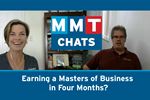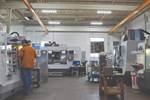Share
Read Next

Best Tool & Engineering (BTE) President Joe Cherluck and Business Development Manager Isaac Trevino have been working together on the business’ growth strategy by analyzing and then identifying their top three focus areas. Source (All Images) | Best Tool & Engineering
I met Joe Cherluck, president of Best Tool & Engineering, in 2020 when I profiled the mold shop and discovered its unique business strategy. Cherluck attended a comprehensive four-month Goldman Sachs 10,000 Small Business program for entrepreneurs that transformed his approach to the business and led him to the Entrepreneurial Operating System (EOS). This simple, proven business operating system helps businesses clarify, simplify and achieve their vision with a six-key component approach: vision, data, process, traction, issues and people.
The first step was to answer the question, “How are we achieving growth?” They were able to answer this question after analyzing eight key points for continuous growth and pinpointing their top three:
- Growth & Opportunities
- Money & Metrics
- Leadership
- People
- Marketing & Selling
- Operations & Processes
- Being Bankable
- Action for Growth.
Now, keep in mind there are four types of growth to consider: rapid, incremental, episodic and plateau growth. Best Tool was stuck in the plateau phase, repeatedly hitting ceilings. Cherluck’s goal was to work with Business Development Manager Isaac Trevino to transition into incremental growth. “The obstacles preventing us from doing so are related to people, operations and processes, and marketing and selling, so those were the three critical areas to address first,” says Cherluck.
The Foundational Three
With Operations and Processes, People, and Marketing and Selling creating the most disruption and demanding the most critical decisions, Cherluck and Trevino built the plan around these three areas.
1. Operations & Processes
“The challenge with operations and processes is recognizing what once worked well may not be scalable as your business grows,” says Trevino. “We started addressing this by defining our processes, emphasizing how work moves through the shop and developing live, evolving documents.”
“Remember, scaling a business is a journey filled with disruptions and decisions. Identify your pain points, tackle them strategically and stay adaptable to keep your moldmaking business on a path to growth.”
They also considered implementing an ERP system but postponed this effort due to the risk of failing to implement it effectively. When evaluating ERP vendors, they found that the compatibility score for their specific needs was less than ideal, which could be a hurdle. “Our current approach is to carefully assess which aspects we can live with or without as we move forward,” says Trevino, “It’s a question of ‘What's stopping our growth?’ and then ranking everything from scheduling to purchasing.”
In Best Tool’s case, scheduling is the largest hurdle because they have a lean team and hot jobs make resource scheduling a nightmare. They also heavily weighed usability from an operator standpoint because they cannot spend a lot of money and time on something the team will not want to use.
After speaking with eight companies — large players and other smaller niche companies Figure 1 — they decided to move forward with Global Shop Solutions, largely because of its scheduling module. “It’s been a lengthy process, about nine months, with many rounds of interviews, but for something you know has a 75% failure rate, it’s necessary. There are a lot of great ERPs out there, but you have to find the one that is going to work best for your company,” says Trevino.
Figure 1. Spreadsheet tool Best Tool uses to interview and assess supplier capabilities, offerings and benefits. The goal is to easily illustrate each company's usability score. The questions are unique to Best Tool's needs.
2. People
Finding and training employees is a constant pain point. Initially, Best Tool attempted to be the trainers themselves, but it proved time-consuming and took away from essential work. They are now working with an outside training company that specializes in providing fundamental training remotely, while Best Tool
handles the specific training on-site.
Cherluck found Praeco Skills out of West Michigan after a quick internet search for basic machining training. The team is working with owner, Ryan Pohl, to develop the resources needed to successfully train someone remotely.
“Training includes safety, speeds and feeds, tool familiarity, workholding and so on,” explains Trevino. “It’s conducted in person at Praeco Skills’ facility but we do it virtually here. It runs twice a year with a class once a week. One of our employees just finished the class. We are developing a binder with instructions on what materials, equipment and demonstrations we need to have here as we can't go out into the shop with Ryan.”

BTE’s action plan for growth strives to improve operations, employee training and marketing efforts while considering new products, new services and customers/markets.
3. Marketing and Selling
This area can be particularly challenging in highly competitive markets. To stand out, Cherluck and Trevino identified a unique service they offer — plastic welding. They noticed a gap in the market where potential customers were searching for these specific services.
“Joe noticed a gap for low-volume welding. The equipment, being specialized, comes with a price tag that can only be justified with high-volume production, but what if you only need 100 welded parts? What do you do?” says Trevino.
So, they optimized their online presence and their efforts paid off with a significant contract with an energy company.
“In terms of sales, we realize the importance of consistent efforts, which a part-time salesperson can maintain,” he continues. “A single call, an email or a knock on the door every day adds up to substantial progress over time. This ongoing dedication has opened doors to opportunities we might have missed otherwise.”
This salesperson is dedicated to outside sales. He’s been in the sales industry for 30-plus years, from bay doors to machining. He’s been a good friend of Cherluck’s for a while and has been able to help get the company’s foot in the door with many industries, such as rail, stamping dies and consumer products.
The growth process is ongoing and understanding that failure is part of the process is essential. However, it's through challenges that you’ll ultimately find success.
The Other Five
Beyond those three foundational areas to transform Best Tool’s growth opportunities, the team also began taking networking more seriously, expanding their reach and establishing valuable connections. They quickly learned that networking can lead to unexpected opportunities and partnerships.
For example, they began attending trade shows and conferences and going on plant tours. “We have made valuable connections, such as Allied Laser Welding, who helped us with a 16-cavity medical mold. We've also connected directly with OEM representatives (Rivian, Lucid, GM) who make the call on sourcing welding programs. Trade shows have expanded our reach toward the west of Michigan,” says Cherluck.
When it comes to money and metrics, Cherluck discovered that for a business to be financially stable, it’s vital to have a diversified customer base. Best Tool applies what they call the “airline seat rule” to oversell and outsource the excess to maintain consistent work levels. This strategy helps to reduce cyclicality in their revenue by preventing a sudden drop in work in a specific sector.
To establish its network of trusted contractors, Trevino is part of a small business machine shop group on Facebook. He posted on the platform and attracted a lot of attention, from which he was able to identify some qualified local shops to add to their contractor network. Trevino has also connected with local mold shops through the American Mold Builders Association (AMBA) — visiting, touring and sending quotes.
As Best Tool grows and adds more employees, leadership roles become crucial, so they have begun preparing for this transition by teaching potential leaders how to manage others and set clear expectations. The biggest portion involves defining and communicating expectations. A few recent hires over the last few years have helped them patch up communication channels.
They also maintain a strong relationship with their bank by keeping the line of communication open with the lenders, so when a large project presents itself, they’re more apt to help out.
“You have to know your financial situation and what the banks are looking for,” says Cherluck. “You must be able to effectively understand your profit/loss and balance sheet and communicate with your banker in those terms. You also need to speak regularly with the lenders even if you have no need at the current time. Keeping the line of communication is critical when you eventually need it.”
Last but not least, the company’s action plan for growth involves addressing critical issues as they emerge and continuously striving to improve operations, employee training and marketing efforts. They use weekly management meetings to review growth in three facets: (1) new products, (2) new services and (3) new customers/markets.
“Once a new opportunity presents itself through sales or any other channel, we use a spreadsheet to review its financial viability before taking it on,” says Cherluck (Figure 2).
The process is ongoing, and Cherluck and Trevino understand that failure is part of the process, but it’s through such challenges that they’ll ultimately find success. “Remember, scaling a business is a journey filled with disruptions and decisions. Identify your pain points, tackle them strategically and stay adaptable to keep your moldmaking business on a path to growth,” says Cherluck.
Related Content
The Critical Role of Management Representatives in ISO 9001
In ISO 9001 quality management systems, the Management Representative (MR) plays a crucial role. While the 2015 version of ISO 9001 no longer mandates this position, having a trusted management member serve as an MR remains vital for streamlining operations and maintaining quality standards.
Read MoreMMT Chats: 4 Keys to a Successful Mold-Building Operation: Innovation, Transparency, Accessibility and Relationship
MoldMaking Technology Editorial Director Christina Fuges chats with Steve Michon, co-owner of Zero Tolerance in Clinton Township, Michigan, about the excitement of solving problems, the benefits of showing gratitude, the real struggle with delegation and the importance of staying on top of technology. This episode is brought to you by ISCAR with New Ideas for Machining Intelligently.
Read MoreDynamic Tool Corporation – Creating the Team to Move Moldmaking Into the Future
For 40+ years, Dynamic Tool Corp. has offered precision tooling, emphasizing education, mentoring and innovation. The company is committed to excellence, integrity, safety and customer service, as well as inspiring growth and quality in manufacturing.
Read MoreTop 10 Topics to Cover During an ISO 9001 Manufacturing Audit
Take a look at this practical hands-on approach to conducting a quality audit.
Read MoreRead Next
Editorial Advisory Board 2023-2026: Meet New Board Member Isaac Trevino, Best Tool & Engineering
The 2023-2026 version of MoldMaking Technology’s EAB features a new crew of industry professionals. Here’s one of them.
Read MoreMMT Chats: Earning a "Masters of Business" in Four Months?
MoldMaking Technology Editorial Director Christina Fuges chats with Joe Cherluck, President of Best Tool & Engineering about transforming his mold shop into a mold business with a free “masters of business” that covers managing growth, money metrics, leadership, marketing, sales and negotiation. This episode is brought to you by ISCAR with New Ideas for Machining Intelligently.
Read MoreMichigan Mold Builder Gets Business Savvy and Adds Vibration and Hot Plate Welding Services
Best Tool & Engineering identifies a new niche in vibration and hotplate welding and beefs up its business management skills.
Read More

























